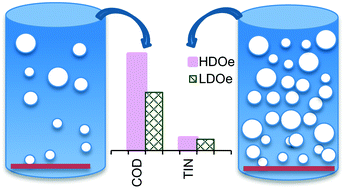Hypoaeration of activated sludge to reduce energy requirements at distributed reclaimed water plants: studies at bench and pilot scales†
Abstract
As stresses on water infrastructure mount, reuse of wastewater for non-potable applications becomes increasingly important. One strategy for providing water to areas geographically distant from existing centralized wastewater treatment plants is distributed water reclamation plants (WRPs)—small WRPs located close to customers produce water that meets specific requirements of the end-users. Economic benefits include minimizing infrastructure for delivery and avoiding over-treatment of the water. However, small WRPs require more energy and staff time per volume of water reclaimed, thus energy use needs to be reduced within existing, proven, robust WRP technologies. To date, energy reduction has focused on mechanical optimization at large plants, reporting 10–38% savings, but treatment strategies for small WRPs are needed to promote distributed water reclamation. In this research, hypoaeration (biological treatment under 0.5–0.8 mg L−1 dissolved oxygen (DO) concentration) was investigated to reduce aeration requirements of treatment in sequencing batch reactors at bench (54 L d−1) and demonstration (29 500 L d−1) scales. Domestic wastewater was successfully treated for 43 and 93 days (respectively), and at both scales the hypoaerobic conditions provided treatment equal to standard treatment conditions (DO = 2.0 mg L−1). At the demonstration-scale, the hypoaerobic treatment reduced blower energy requirements by 27% and solids production by 10–12%, which reflects a potential energy saving of 21% in a small WRP.



 Please wait while we load your content...
Please wait while we load your content...